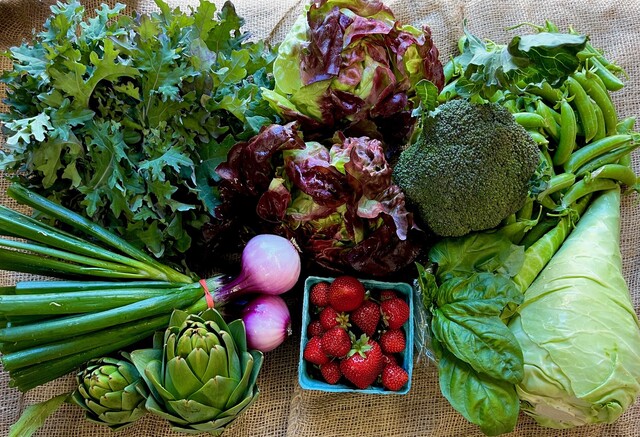- Head lettuce
- Broccoli
- Green Cone Cabbage
- Basil
- Sugar Snap Peas
- Purplette Onions
- Strawberries
- Kale
On Rotation:
- Artichokes
If ever there was a "signature" Week 6 share, this is it: dainty Purplette onions, fat Sugar Snap peas, tender-sweet Caraflex cabbage, heavy heads of broccoli, bright red strawberries, luxurious basil. With one major exception: artichokes! Starting this week artichokes will be on rotation, which has never happened in the July CSA shares before. We typically move our artichoke patch every five years or so, usually in the late Fall. We missed the window to do it last fall, so they got divided and moved in February instead. That delayed their development by a couple of months, so instead of budding in April/May, which is their usual peak season, we're getting July chokes instead. These new plants are HUGE - wading through them for harvest feels like a journey into some prehistoric thistle patch, with spiky chokes bobbing above the foliage everywhere you turn.
The Valley Flora artichoke is somewhat of a local legend. They've been in our family for over fifty years, since the early 1970's when my mom's friend gave her a division from her garden on Short Street in Bandon. My mom tended and divided that plant and turned it into multiple clumps of artichokes in her own garden. Throughout my entire childhood we savored those chokes in the late spring (dipped in melted butter of course). When I moved to Portland after college in 2003, my mom gave me a few divisions for my own backyard. They threw chokes reliably, even in Portland's more extreme inland climate. When I finally moved back to Langlois, I brought my artichokes with me: forty bare root divisions that I planted out into the field next to 300 Green Globe starts that I'd germinated from a seed packet.
Once those Green Globes started producing that first season, it became apparent immediately how superior the "Mother Choke" was: those forty original plants out-yielded the three hundred Green Globes; the chokes were more beautiful and uniform; they had far better flavor; and, most striking of all, they were practicly chokeless (the "choke" is the hairy part of the flower bud, just above the heart as you eat down through the leaves). When you eat a smaller Valley Flora artichoke, you'll find that you can eat it from the bottom up, no hairy choke to choke on. The Mother Choke also puts out a smaller, secondary flush of chokes in the Fall (bonus)!
As the plants came through their first winter of frost, snow and heavy rain, it became obvious that there was no point in keeping those Green Globes around. The Mother Chokes took every beating that winter threw at them - including a 17 degree cold snap - and bounced right back, while the Green Globes faltered and many died. I wasted no time in tilling the Globes under, dividing the row of Mother Chokes yet again, and replanting the patch with our own stock. Sixteen years later they're going stronger than ever on the farm - in July!
If Valley Flora had a mascot, most of the public would probably chose the strawberry. But deep down, I think it's the artichoke. It represents the five+ decades that this land has cupped us in its palm along Floras Creek, generously feeding us unusual and beautiful things every season over the span of three generations. People usually speak of humans as the ones who "tend" and "nurture" a piece of land - and while it's certainly true that we spend our every waking moment loving on this place - at the end of the day I feel like it's the land that's tending, nurturing and filling us with life.
There is a Kalapuya saying that I keep on a post-it note at my desk:
A homeland, an Ilihi, cannot be possessed, it possesses its people, it holds them.
For this beautiful homeland, and for the artichoke that grows so well within it, nothing but gratitude.

